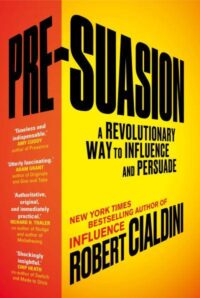Reading Notes for:


If/When-Then Plans
From time to time we all set objectives for ourselves, targets to hit, standards to meet and exceed. But too often, our hopes go unrealized as we fail to reach the goals.
First, besides sometimes forgetting about an intention—let’s say, to exercise more—we frequently don’t recognize opportune moments or circumstances for healthy behaviors, such as taking the stairs rather than the elevator. Second, we are often derailed from goal strivings by factors—such as especially busy days—that distract us from our purpose.
Fortunately, there is a category of strategic self-statements that can overcome these problems pre-suasively. The statements have various names in scholarly usage, but I’m going to call them if/when-then plans. They are designed to help us achieve a goal by readying us (1) to register certain cues in settings where we can further our goal, and (2) to take an appropriate action spurred by the cues and consistent with the goal. Let’s say that we aim to lose weight. An if/when-then plan might be “If/when, after my business lunches, the server asks if I’d like to have dessert, then I will order mint tea.” Other goals can also be effectively achieved by using these plans. When epilepsy sufferers who were having trouble staying on their medication schedules were asked to formulate an if/when-then plan—for example, “ When it is eight in the morning, and I finish brushing my teeth, then I will take my prescribed pill dose”—adherence rose from 55 percent to 79 percent.
Merely stating an intention to reach a goal or even forming an ordinary action plan is considerably less likely to succeed. There are good reasons for the superiority of if/when-then plans: the specific sequencing of elements within the plans can help us defeat the traditional enemies of goal achievement. The “if/when-then” wording is designed to put us on high alert for a particular time or circumstance when a productive action could be performed. We become prepared, first, to notice the favorable time or circumstance and, second, to associate it automatically and directly with desired conduct. Noteworthy is the self-tailored nature of this pre-suasive process. We get to install in ourselves heightened vigilance for certain cues that we have targeted previously, and we get to employ a strong association that we have constructed previously between those cues and a beneficial step toward our goal.
Just as the designers of our information technology software have installed rapid access to particular sources of information within our computers’ programming, the designers of our lives—parents, teachers, leaders, and, eventually, we ourselves—have done the same within our mental programming. These prefetched sources of information have already been put on continuing “standby” in consciousness so that only a single reminder cue (click) will launch them into action.
This recognition highlights the potential usefulness of if/when-then plans for accomplishing our main goals. These goals exist as prefetched sources of information and direction that have been placed on standby, waiting to be launched into operation by cues that remind us of them.
Chronically unsuccessful dieters eat fewer high-calorie foods and lose more weight after forming if/when-then plans such as “If/when I see chocolate displayed in the supermarket, then I will think of my diet.”
CORRECTION: MINDING THE GAP
To this point, we’ve covered a lot of data showing that (1) what is more accessible in mind becomes more probable in action, and (2) this accessibility is influenced by the informational cues around us and by our raw associations to them. The section on if/when-then plans and the chapter on the geography of influence provided welcome evidence that we can derive higher-order benefits from these elementary processes.
Mere Reminders
We all know that when we are in a good mood, the people and items around us seem better somehow.
One study showed that a man who complimented young women and then asked for their phone numbers to arrange a date was considerably more successful when he asked on a sunny morning versus a cloudy morning (22.4 percent and 13.9 percent success rates, respectively).
Sunny days don’t just inflate how we feel about what we own and the people we meet; they do the same for how we feel about our lives. Individuals surveyed by phone reported themselves 20 percent more satisfied with their existence—as a whole—when asked on sunny days compared with rainy days. Hence, the unappealing leaf-in-the-wind (and, it appears, rain) label looks to fit our species lamentably well. Fortunately, there’s an optimistic side to the findings: the label’s fit differed dramatically when respondents were reminded of the weather before the survey began. If the interviewer asked first, “By the way, how’s the weather over there?” the sunny-versus-rainy-day effect didn’t materialize at all. Simply being focused on the weather for a moment, reminded the survey participants of its potentially biasing influence and allowed them to correct their thinking accordingly.
A quote from Hollywood director Gregory Ratoff, who said, “Let me ask you a question, for your information.”
Although the book’s authors consider Ratoff’s quote nonsensical, I disagree. Posing a question can provide invaluable information to its recipient.
In the realm of self-correction mechanisms, then, we can find another source of validation for a core tenet of pre-suasion: immediate, large-scale adjustments begin frequently with practices that do little more than redirect attention.
A belief among many product-placement practitioners is that the more perceptible the constructed connection, the more effective it will be. This view stems from the seemingly inescapable logic that the prominence of a piece of information increases the chance that audience members will notice it and thereby be influenced by it. The opinion is bolstered by evidence that more prominent product placements are, in fact, more effective, as judged by the standby advertising industry measures of success: recognition and recall, which gauge memory for what was encountered.
But besides assessing recognition and recall, the study’s authors did something that prior researchers had not done: they obtained a third measure of placement success that undercut conventional wisdom. From a list of brands, audience members indicated which ones they would be likely to choose when shopping. Guess what? It turned out that the survey respondents were least likely to select the products that had been inserted most prominently. It seems that the conspicuousness of the placements cued viewers to the advertisers’ sly attempts to sway their preferences and caused a correction against the potential distortion. Whereas the most subtly placed brands were chosen by 47 percent of the audience, only 27 percent picked the most prominently placed ones.
People recognize that advertisers’ practices can influence their judgments unduly, but it’s not until they are reminded of the source of the possible bias that they act to rebalance the system. In this instance, the reminder took the form of a nudge too far—an overly exposed version of the trick (of fictionally established linkages) at play
Sometimes the adjustments we make to counteract unwarranted influences take place without much forethought or delay. The recalibrations that occur when we are reminded of current weather conditions are a good example. Other times, the correction mechanism works much more planfully and slowly. This second kind of mechanism operates through deliberative reasoning, which can be used to overcome biases that flow from rudimentary psychological tendencies. If we go to the supermarket with the idea of purchasing healthy, nutritious, and inexpensive foods, we can neutralize the draw of heavily advertised, attractively packaged, or easy-to-reach items on the shelves by weighing our choices on the basis of caloric, nutritional, and unit-pricing information on the labels.

